Graf Neipperg
The lover of Napoleon's wife: Neipperg
Während ich ein herrliches Glas Rotwein genoss, kam mir der Gedanke: Warum nicht den Vorfahren von Sophie Salm, Adam Albert von Neipperg (1775-1829), als Inspiration für ein neues Projekt nutzen?

Wer ist Neipperg?
Da Sophie ein direkter Nachkomme von Adam Albert Graf Neipperg ist, kam mir der Gedanke Graf Neipperg als Sujet zu benützen. Diese familiäre Verbindung könnte eine einzigartige Möglichkeit bieten, die Geschichte des Adam Albert auf besondere Weise darzustellen.
Adam Albert von Neippergs Spuren und Leben sind unbestreitbar fesselnd, und der Drang, seine Geschichte auf sinnvolle Weise zu erzählen, kam in mir auf.
Adam Albert von Neipperg war eine komplexe und faszinierende Persönlichkeit. Er war ein erfolgreicher Soldat, ein Diplomat und ein Förderer der Künste. Aufgrund seiner Beziehung zu Marie-Louise von Österreich (1791-1847) war er auch eine umstrittene Figur. Dennoch war er zweifellos eine bedeutende Persönlichkeit in der Geschichte Österreichs und Italiens.
Wer ist Graf Neipperg ?
Adam Albert von Neipperg
Adam Albert von Neippergs Persönlichkeit wurde von Méneval - Napoleon et Marie-Louise, Bd. II, S. 166-167 1843 - in überwiegend positiven Tönen beschrieben:
"Das Verhalten des Grafen Neipperg war das eines umsichtigen Mannes. Sein üblicher Gesichtsausdruck war freundlich, gemischt mit Eifer und Ernsthaftigkeit. Seine Umgangsformen waren höflich, anzüglich und schmeichelhaft. Er besaß angenehme Talente; er war ein guter Musiker. Aktiv, klug und skrupellos, verstand er es, seine Arglist unter dem Deckmantel der Einfachheit zu verbergen; er konnte sich gut ausdrücken und auch gut schreiben. Mit viel Taktgefühl verband er einen sehr aufmerksamen Geist; er hatte die Kunst, zuzuhören und den Worten seines Gesprächspartners aufmerksam zu folgen. In einem Moment nahm sein Gesicht einen liebevollen Ausdruck an, in einem anderen versuchte sein Blick, Gedanken zu erraten. Er war ebenso geschickt darin, die Pläne anderer zu durchschauen, wie er klug darin war, seine eigenen zu steuern. Da er den Anschein großer Bescheidenheit mit einem tiefen Grund von Eitelkeit und Ehrgeiz verband, sprach er nie über sich selbst. Im Krieg war er tapfer; seine vielen Wunden zeigten, dass er sich nicht geschont hatte."
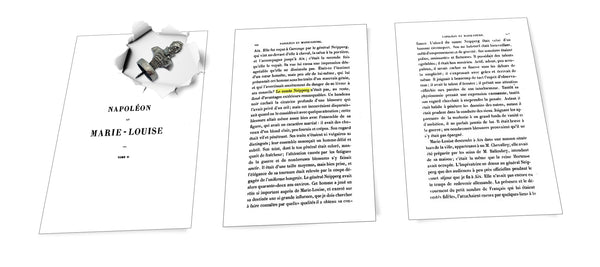
Die Ausbildung eines jungen deutschen Adligen
Adam Albert wurde an der Militärakademie Karlsschule in Stuttgart ausgebildet. Er trat 1791 in die österreichische Armee ein und diente in den französischen Revolutionskriegen und den napoleonischen Kriegen. Er stieg bis zum Rang eines Feldmarschall-Leutnants auf.
Neipperg's Augenverletzung
Adam Albert von Neipperg verlor am 14. September 1794 während der französischen Revolutionskriege bei einem Gefecht im Dorf Doel sein rechtes Auge. Er war auf einer Mission, um geheime Anweisungen an Festungen in der niederländischen Republik zu übermitteln, als er hinter den feindlichen Linien in eine Falle geriet. Er wurde mit einem Bajonett so schwer verwundet, dass er für tot gehalten wurde, und verlor bei dieseem Gefecht sein rechtes Auge.
Neipperg wurde am nächsten Tag von den Franzosen lebend gefunden, die ihn für einen Verräter hielten, weil er für einen einfachen Soldaten zu gut Französisch sprach. Er wurde zu Tode verurteilt aber siene Genesung dauerte aufgrund der Schwere seiner Verletzungen sehr lange. Als er wieder gesund war, hatte sich der politische Wind geändert, und er konnte an einem Gefangenenaustausch teilnehmen.
Neipperg trat wieder in die österreichische Armee ein und nahm 1795 an der Schlacht von Mainz teil. Er führte österreichische Truppen in Italien, was 1800 in der verheerenden Schlacht von Marengo gipfelte, durch die die Österreicher aus Italien vertrieben wurden. Trotz seiner Verletzung schlug Neipperg eine erfolgreiche militärische Laufbahn ein und wurde schließlich ein enger Berater des österreichischen Kaisers Franz.
Es ist erwähnenswert, dass die Berichte darüber, wie Neipperg sein Auge verlor, voneinander abweichen. In einigen Quellen heißt es, dass er durch einen Säbel verwundet wurde, in anderen, dass er mit einem Bajonett durchbohrt wurde. Alle Berichte stimmen jedoch darin überein, dass er sein rechtes Auge bei einem Gefecht am 14. September 1794 verloren hat.
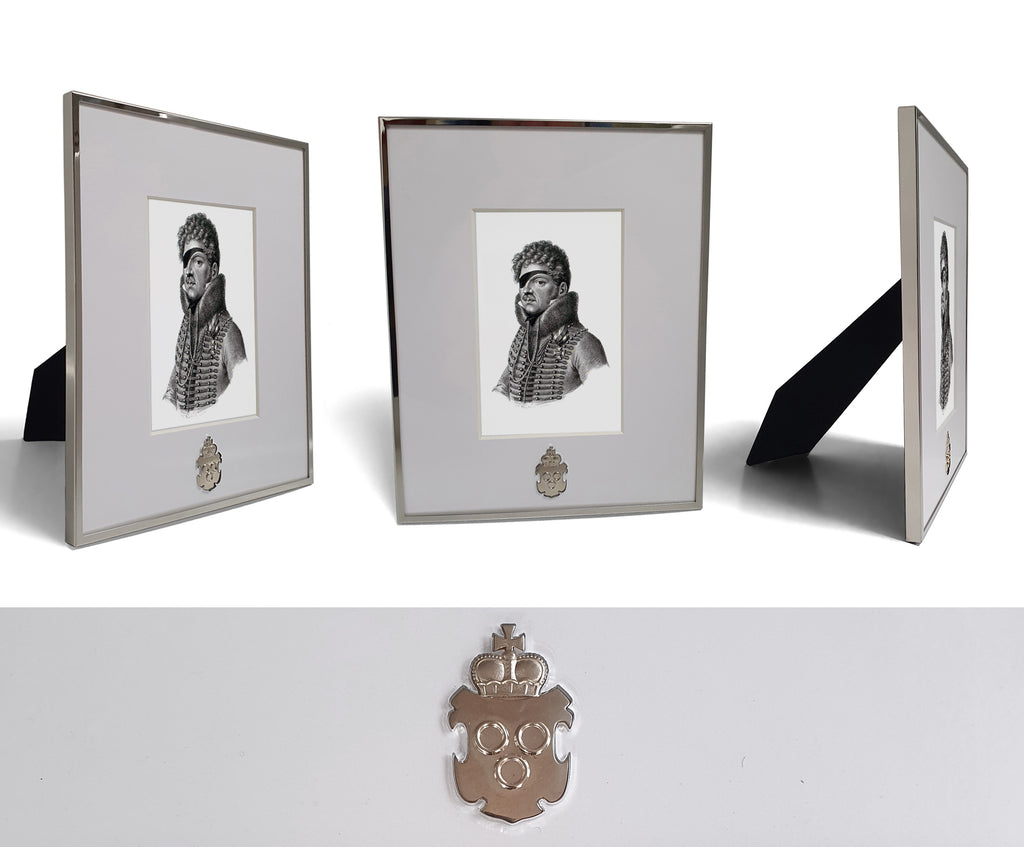
source: handmade by Sophie Salm in 2020
Neben seiner erfolgreichen militärischen Karriere war Adam Albert auch ein erfolgreicher Diplomat. Er diente von 1811 bis 1813 als österreichischer Botschafter in Schweden. Er war auch ein Förderer der Künste und Wissenschaften.
Adam Alberts erste Ehe
Adam Alberts Kinder (die Neipperg'sche Linie)
Adam Alberts erste Frau, Josephine Walpurgis, Gräfin von Pola (1778-1815), die er 1806 heiratete, war eine italienische Gräfin aus einer Familie, die am österreichischen Hof kaum bekannt war. Die Beweggründe für diese Heirat sind nicht ganz klar, aber es ist möglich, dass Adam Albert an Josephines Mitgift interessiert war. Bekannt ist, dass Josephine Walpurgis bereits geschieden war, was sie zu einer gesellschaftlich fragwürdigen Ehefrau machte. Trotzdem führte das Paar eine erfolgreiche Ehe, aus der 4 männliche Nachkommen hervorgingen.
Josephine und Adam Albert hatten vier Söhne:
- Graf Alfred von Neipperg (1807-1865)
- Graf Karl von Neipperg (1809-1854)
- Graf Franz von Neipperg (1810-1853)
- Graf Wilhelm von Neipperg (1811-1881)
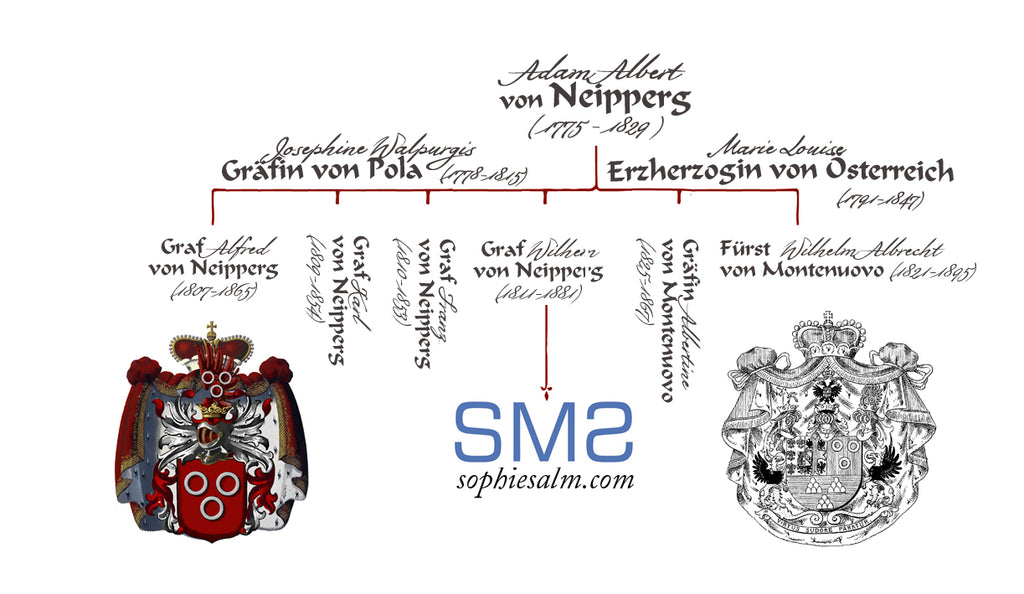
Adam Alberts zweite Ehe
Als seine erste Frau, Josephine Walpurgis, 1815 verstarb, hatte Adam Albert bereits seine zweite Frau, Marie-Louise von Österreich (1791-1847), kennen gelernt. Aus der Korrespondenz Dritter wissen wir, dass sich die beiden 1812 bereits kannten. Ihre romantische Liaison scheint sich jedoch erst einige Jahre später, 1814, entwickelt zu haben, als Adam Albert den Auftrag erhielt, Marie-Louise von Frankreich zurück nach Österreich zu begleiten.
Der Liebhaber von Napoleons Frau
Trotz seiner herausragenden diplomatischen Karriere und seiner Erfolge auf dem Schlachtfeld ist Neipperg vor allem für seine Beziehung mit Marie Louise von Österreich, der zweiten Frau von Napoleon Bonaparte, in Erinnerung geblieben.
Napoleon Bonaparte und Adam Albert von Neipperg
Obwohl es wahrscheinlich ist, dass sich Napoleon und Adam Albert nie begegnet sind, haben sie bei mehr als einer Gelegenheit im übertragenen Sinne die Schwerter gekreuzt.
Neippergs Rache
Die Grafschaft Neipperg war ein kleines souveränes Territorium innerhalb des Heiligen Römischen Reiches. Sie wurde von der Familie Neipperg regiert, die ein bekanntes deutsches Adelsgeschlecht war. Im Jahr 1806 löste Napoleon das Heilige Römische Reich auf und schuf den Rheinbund. Die Grafschaft Neipperg war eines der Territorien, die im Rahmen dieser Neuordnung aufgelöst wurden und schließlich Teil des Königreichs Württemberg wurden.

Auch wenn Adam Alberts Entscheidung, sich auf eine Affäre mit Napoleons Frau einzulassen, nicht in erster Linie durch Napoleons Mediatisierung der Grafschaft Neipperg motiviert war, verschaffte sie ihm wahrscheinlich ein wenig Schadenfreude.
Im August 1814 erhielt er den Befehl, die Kaiserin Marie Louise, Napoleons Frau, nach Österreich zu begleiten. Das eigentliche Ziel seines Auftrags war es, die Kaiserin davon abzuhalten, Napoleon im Exil auf Elba zu folgen. Neipperg, der diese Absicht klar verstand, wurde mit den Worten zitiert: "Innerhalb von sechs Monaten werde ich ihr Liebhaber und bald ihr Ehemann sein" Geer, Walter (1925), Napoleon and Marie-Louise; the fall of the empire, New York, Brentano's, S.315.
Wie wurde Marie Louise von Österreich die Frau von Napoleon Bonaparte?
Napoleon, der Gegenstand eines 2023 von Ridley Scott inszenierten Films ist, hat bekanntlich seine Ehe mit Kaiserin Josephine de Beauharnais annulliert, weil sie nicht in der Lage war, ihm Kinder zu gebären.
Napoleon Film 2023
Napoleon ist derzeit ein unveröffentlichter Spielfilm von Ridley Scott.
Im Mittelpunkt des historischen Dramas stehen Napoleon Bonaparte, sein Aufstieg zur Macht und seine Ehe mit Joséphine de Beauharnais. Für die Titelrolle wurde Joaquin Phoenix auserwählt. Anna Mawn dürfte Erzherzogin Marie-Louise, Napoleons zweite Frau, spielen.
Napoleons Heirat mit Marie-Louise war sowohl von seinem Wunsch nach einem Erben als auch von einem strategischen Bündnis mit einem bedeutenden europäischen Königshaus wie den Habsburgern geleitet.
Habsburg-Lothringen Erbstück
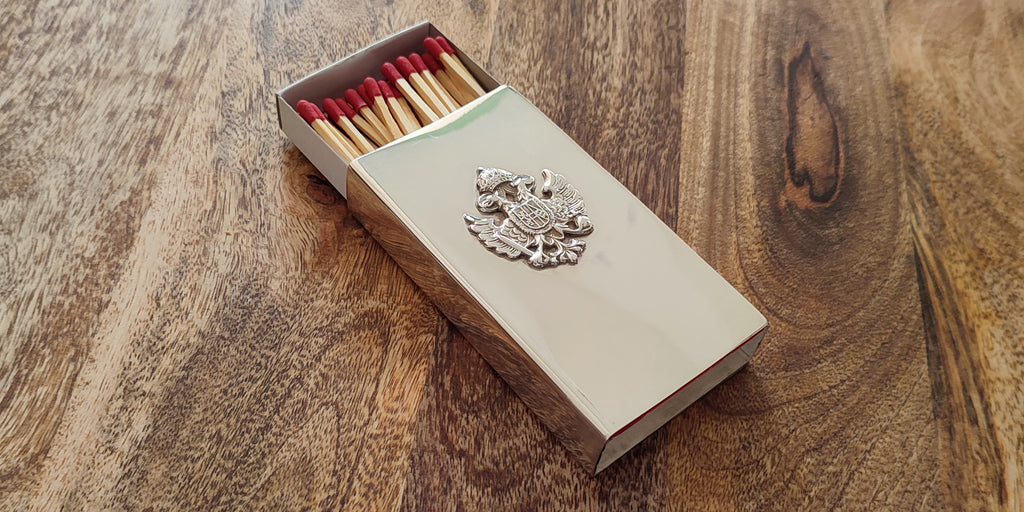
source: handmade by Sophie Salm in 2019
Erbstück, das den Doppeladler zeigt, wie er vom Haus Österreich verwendet wurde.
Der Neipperg-Skandal in Frankreich
Natürlich verlief die Liaison zwischen Neipperg und Kaiserin Marie Louisa nicht ohne Skandal
„Jeder, der Sardous großes Stück Madame Sans-Gene gesehen (oder das Buch mit diesem Titel gelesen hat), wird sich daran erinnern, dass Graf Neipperg, der österreichische Kammerherr von Kaiserin Marie-Louise, in dem Buch die Rolle des Liebhabers spielt . Der Vater des Fürsten Montenuovo war kein anderer als der Sohn der Kaiserin und des Grafen Neipperg.“
„In der Tat war es infolge dieser Umstände... dass die Familie Neipperg,... es strikt ablehnte, dem neugeborenen Kind die Führung ihres altehrwürdigen Vatersnamens zu gestatten.“ S. 149 Geheime Memoiren
"Der österreichische Kaiser ... verlieh seinem unehelichen Enkel den Namen und Titel eines Grafen Montenuovo, was nicht mehr und nicht weniger ist als die italienische Übersetzung des Wortes "Neipperg", das seinerzeit von "neuer Berg" abgeleitet wurde." Source: p150 Secret memoirs Vol 2, Fontenoy 1900
Der Hauptvorwurf von La Marquise de Fonteneoy scheint zu sein, dass die Kinder von Adam Albert und Marie Louise unehelich waren. Angesichts der Tatsache, dass ihr erstes Kind etwa 2 Jahre nach ihrer Heirat im Jahr 1821 geboren wurde, scheint diese Schlussfolgerung falsch zu sein.
Adam Alberts weiteren Kinder (die Montenuovo Linie)
Es stimmt zwar, dass die Ehe zwischen Adam Albert und Marie Louise geheim gehalten wurde, aber die Ehe war eine Tatsache und ihre Nachkommenschaft legitim.
Die allgemein verbreitete Meinung, dass es sich bei dieser Ehe um eine morganatische Ehe handelte, scheint tatsächlich von Adam Albert selbst zu stammen, der seine zweite Ehe als solches bezeichnete.
Adam Albert könnte tatsächlich (trotz gegenteiliger Behauptungen) mit seiner Behauptung Recht gehabt haben, dass seine Ehe mit Maria Louise von Österreich morganatisch war.
Im Familienstatut des Durchlauchtigsten Erzhauses Österreichs (3. Februar 1839) wird der Familienname Neipperg nicht erwähnt (andere wie Auersperg, Schwarzenberg und Salm Reifferscheidt (und viele andere) schon).
Nach dem Tod von Napoleon Bonaparte am 5. Mai 1821 stand einer Heirat nichts mehr im Wege. Marie Louise von Österreich heiratete Adam Albert Neipperg in einer morganatischen Ehe am 8. August 1821 in Parma, Italien.
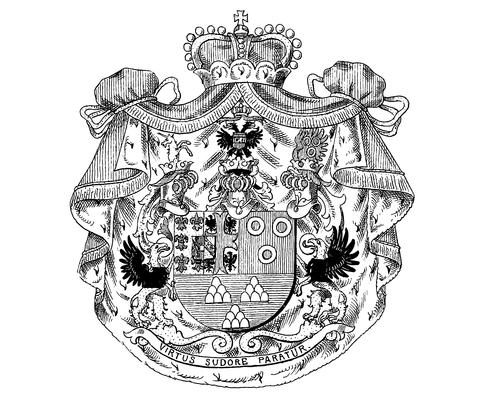
Die Ehe wurde vom österreichischen Kaiser Franz I. anerkannt, und ihre Nachkommen erhielten den Titel der Fürsten von Montenuovo.
- William Albert, 1. Fürst von Montenuovo (1823-1895)
- Albertine, Gräfin von Montenuovo (1825-1867)
Obwohl diese Linie in der männlichen Linie ausgestorben ist, leben Nachkommen aus dieser zweiten Ehe noch in Deutschland und Österreich.
Das Herzogtum Parma, Piacenza und Guastalla
Marie Louise regierte das Herzogtum Parma nach dem Sturz Napoleons von 1814 bis 1847. Während ihrer Regierungszeit setzte sie sich für die Förderung von Kunst und Kultur in der Region ein und prägte das Herzogtum entscheidend mit.
Adam Albert trug nicht nur dazu bei, dass Marie Louise bei den Verhandlungen des Wiener Kongresses das Herzogtum Parma behielt, sondern half ihr auch, das Herzogtum zu regieren.
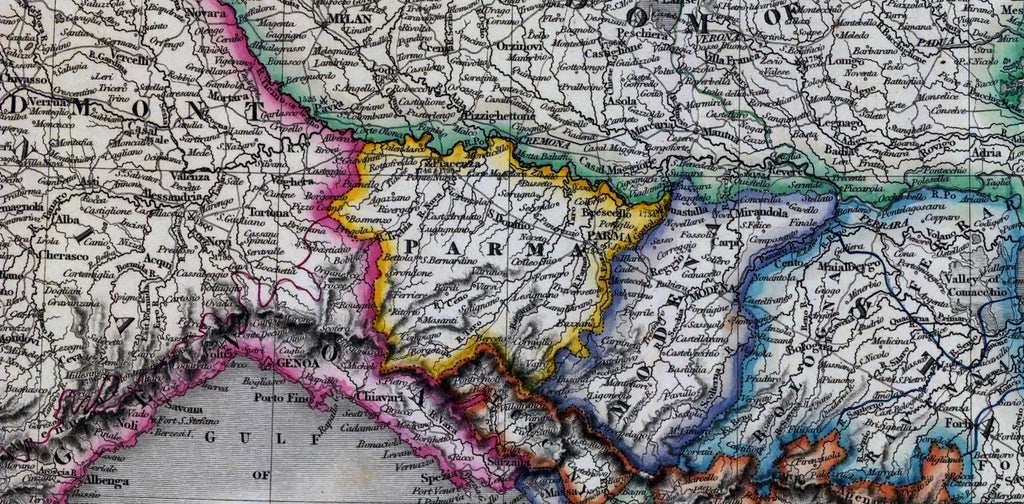
Nach dem Ende der napoleonischen Ära wurde Marie Louise auf dem Wiener Kongress zur Herzogin von Parma ernannt. Im April 1816 übersiedelte sie nach Parma und ließ ihren Sohn in Wien zurück. Graf von Neipperg übernahm die Rolle als ihr wichtigster Berater an, insbesondere in außenpolitischen und militärischen Fragen.
Neippergs Hauptziel bestand darin, Marie Louise vor jeglichem möglichen Einfluss oder Manipulation durch Bonapartisten zu schützen. Marie Louise und Neipperg verfolgten im Vergleich zu vielen anderen italienischen Herrschern einen liberalen Regierungsansatz. Im Jahr 1826 reiste der bonapartistische Graf d’Hérrison durch Parma und stellte fest, dass der Generalissimus Neipperg seine Pflichten effektiv erfüllte.
Nach Marie Louises Tod im Jahr 1847 erlebte das Herzogtum verschiedene politische Veränderungen und wurde schließlich im 19. Jahrhundert in das Königreich Italien eingegliedert.
Tod des Adam Albert Neipperg im Jahr 1829
Adam Albert von Neipperg verstarb am 22. Februar 1829. im Alter von 53 Jahren. Er starb an einem Herzleiden in Parma, Italien. Er wurde in der Kirche von San Francesco in Parma beigesetzt. Der Tod Neippergs war ein großer Schock für Marie Louise. Der österreichische Hof verbot ihr, in der Öffentlichkeit um ihn zu trauern.
Jagdabzeichen und Flaschenverschlüsse
Die Herstellung von Flaschenverschlüssen mit historischen Figuren als Motivbild ist eine Mischung aus Kunst und Geschichte. Jeder Verschluss wird zu einer Hommage an berühmter Persönlichkeiten aus der Vergangenheit. Von königlichen Monarchen bis hin zu revolutionären Denkern - diese Verschlüsse sind eine Hommage an Persönlichkeiten, die unsere Welt geprägt haben. Jeder Stöpsel ist ein Gesprächsanlass und lädt Weinliebhaber dazu ein, ein Glas auf die Vergangenheit zu erheben.
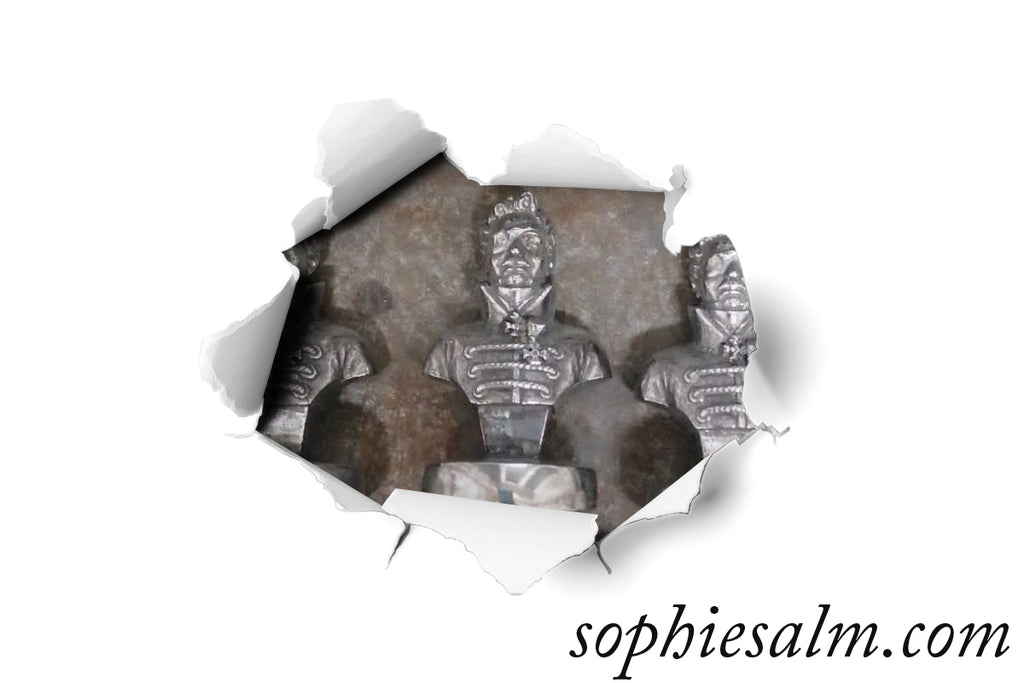
Sophie hat diese Herausforderung gerne angenommen, in der Hoffnung, Adam Alberts außergewöhnliche Geschichte zu neuem Leben zu erwecken und sie einem breiteren Publikum vorzustellen, während sie einen Grand Cru in Erinnerung an Neipperg trinkt.

Begleiten Sie Sophie Salm in Ihrer Jagdjuwelier Werkstatt wo Handwerkskunst auf Kameradschaftlichkeit trifft.
Lesen Sie hier meine anderen Blogs zum Thema Jagd:
Sie können auch ein Jagdabzeichen kaufen, indem Sie dem unten stehenden Link folgen:
Wissenwertes:
Burg Neipperg
Die Burg Neipperg befindet sich in der Stadt Neipperg, Baden-Württemberg, Deutschland. Sie ist der Stammsitz der Grafen Neipperg, eines Adelsgeschlechts mit einer langen und bedeutenden Geschichte. Die Burg wurde 1212 erstmals erwähnt und im Laufe der Jahrhunderte immer wieder erweitert und umgebaut. Heute ist sie ein beliebtes Ausflugsziel und bietet einen herrlichen Blick auf die umliegende Landschaft.
test



